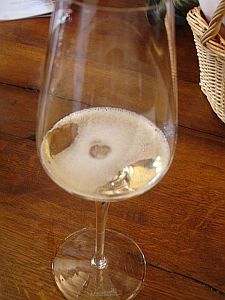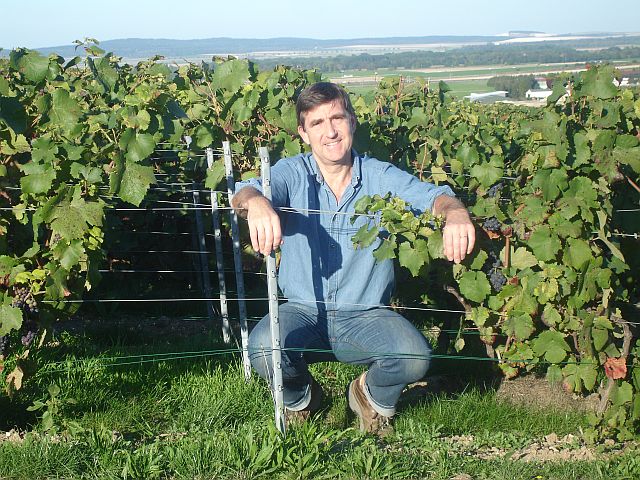Does Size Matter?
 One of the most common assumptions people make about champagne is that small bubbles are a sign of a good quality, as if a champagne with small bubbles is somehow superior to the others.
One of the most common assumptions people make about champagne is that small bubbles are a sign of a good quality, as if a champagne with small bubbles is somehow superior to the others.
There’s a grain of truth in this, but as with so many things, it’s is a bit of an over-simplification and is not a reliable way to judge the quality of one champagne compared to another.
For one thing it is nigh on impossible, with the naked eye, to tell the difference between the size of the bubbles in one glass of champagne compared with another. That’s because there isn’t much difference, if indeed there is any difference at all, between champagnes of the same type, for example non-vintage champagnes.
Why is that? Well, all champagne must be made following the same rules and regulations and if this is done competently, which it almost always is, the result will inevitably be small bubbles.
That is not necessarily true for some other sparkling wines. For example, Prosecco is made by a different process to champagne, a process which is cheaper and produces larger bubbles, so in that sense small bubbles are indeed a mark of quality, but only between sparkling wines made by the traditional method, as in champagne, and those made by some other method.
There is however one crucial factor that does influence the size of the bubbles and to understand a little more about that let’s return to what Professor Liger-Belair of Reims University had to say on the subject in a recent interview.
"The age of the Champagne is a parameter of importance," Liger-Belair says. Corks do not provide an absolute seal, so some CO2 escapes over the years and as the pressure inside the bottles slowly decreases, so too will the size of the bubbles. As professor Liger-Belair says: "Old champagnes show small bubbles because of their age."
So there you have it. Smaller bubbles are an indication of greater age, rather than superior quality per se.
The More The Merrier?
What about the amount of bubbles. Does more bubbles mean better champagne?
Well here again it really comes down to personal preference and to what type of champagne you prefer, or the occasion demands.
What is certain is that the amount of bubbles depends entirely on the amount of dissolved CO2 in the wine. When champagne is bottled yeast and sugar are added to provoke the second fermentation which creates the bubbles. The amount of sugar added is 24 grams of sugar per litre of wine which is a ratio that has been proven to produce 6 atmospheres of pressure inside the bottle.
As we saw earlier however, the bottle is never a perfectly sealed and some CO2 always escapes. The reduction in pressure as the bottle ages in the cellar means not only that the bubbles will be smaller, but that there will be fewer of them too.
So a young, fresh non vintage champagne will have more bubbles than a mature old vintage champagne, but that’s OK because the first is meant for happy occasions on high days and holiday when most people are paying more attention to the celebration than studying the size or number of the bubbles, whilst the vintage champagne is for quieter moments when you have time to linger and appreciate the subtle nuances of the champagne which may well include characteristics of the bubbles.
You get the same loss of bubbles when you open the bottle except that the loss of CO2 will be much faster. Even if you put a topper in a bottle that is not empty, that doesn’t help a great deal – the champagne is still losing fizz fast.
"Inevitably, the second time the Champagne will be served, its level of dissolved CO2 will be less than the first time," Liger-Belair says.
Cramant or Crémant
 If you prefer a slightly less fizzy style of champagne then you may care to open the bottle and leave it open for half an hour, or so, before pouring it.
If you prefer a slightly less fizzy style of champagne then you may care to open the bottle and leave it open for half an hour, or so, before pouring it.
Alternatively there are still a very few champagnes to which a lower amount of sugar is added at the time of bottling. These champagnes have less pressure and fewer bubbles. They used to be called crémant, but the term has been discontinued in Champagne region, but if you search hard enough there are still a few producers who make this style.
Crémant should not be confused with the word Cramant which is the name of a Grand Cru village in la Côte des Blancs. Cramant was one of the first villages to be designated as Grand Cru and many commentators consider that it produces the finest Chardonnay grapes in Champagne.
 Whether you like them or hate them, find them useful or useless, it is hard to deny that over the past 20 years or so the medals and scores given to wine by some recognised authorities have had a significant impact on the sales of the wines in questions, but what of the future? Will Parker points’ continue to be influential and of not, what, if anything will replace them?
Whether you like them or hate them, find them useful or useless, it is hard to deny that over the past 20 years or so the medals and scores given to wine by some recognised authorities have had a significant impact on the sales of the wines in questions, but what of the future? Will Parker points’ continue to be influential and of not, what, if anything will replace them?

 April is Champagne is becoming something of an institution.
April is Champagne is becoming something of an institution. One of the most common assumptions people make about champagne is that small bubbles are a sign of a good quality, as if a champagne with small bubbles is somehow superior to the others.
One of the most common assumptions people make about champagne is that small bubbles are a sign of a good quality, as if a champagne with small bubbles is somehow superior to the others. If you prefer a slightly less fizzy style of champagne then you may care to open the bottle and leave it open for half an hour, or so, before pouring it.
If you prefer a slightly less fizzy style of champagne then you may care to open the bottle and leave it open for half an hour, or so, before pouring it.  Bubbles are part of the fun of drinking champagne and a good deal has been said and written about them. Some of this is fact and some of it is faction; in this article you’ll discover which is which.
Bubbles are part of the fun of drinking champagne and a good deal has been said and written about them. Some of this is fact and some of it is faction; in this article you’ll discover which is which. In Champagne more and more small producers are coming to the conclusion that a good way to add value and to differentiate themselves from each other, and from the big brands, is to emphasise their terroir. What better way to do this, according to these producers, than to put the name of the village of origin prominently the label?
In Champagne more and more small producers are coming to the conclusion that a good way to add value and to differentiate themselves from each other, and from the big brands, is to emphasise their terroir. What better way to do this, according to these producers, than to put the name of the village of origin prominently the label?